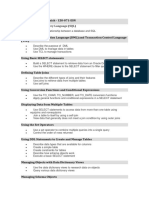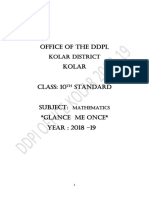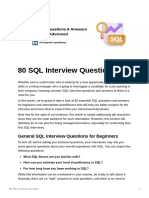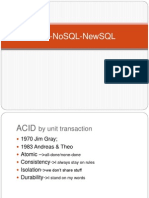0 ratings0% found this document useful (0 votes)
45 viewsSQL Syllabus
Uploaded by
kusuma mCopyright
© © All Rights Reserved
We take content rights seriously. If you suspect this is your content, claim it here.
Available Formats
Download as PDF, TXT or read online on Scribd
0 ratings0% found this document useful (0 votes)
45 viewsSQL Syllabus
Uploaded by
kusuma mCopyright
© © All Rights Reserved
We take content rights seriously. If you suspect this is your content, claim it here.
Available Formats
Download as PDF, TXT or read online on Scribd
You are on page 1/ 4
Syllabus of SQL Training in Bangalore
Introduction to Oracle Database
List the features of Oracle Database 11g
Discuss the basic design, theoretical, and physical aspects of a relational database
Categorize the different types of SQL statements
Describe the data set used by the course
Log on to the database using SQL Developer environment
Save queries to files and use script files in SQL Developer
Retrieve Data using the SQL SELECT Statement
List the capabilities of SQL SELECT statements
Generate a report of data from the output of a basic SELECT statement
Select All Columns
Select Specific Columns
Use Column Heading Defaults
Use Arithmetic Operators
Understand Operator Precedence
Learn the DESCRIBE command to display the table structure
Learn to Restrict and Sort Data
Write queries that contain a WHERE clause to limit the output retrieved
List the comparison operators and logical operators that are used in a WHERE clause
Describe the rules of precedence for comparison and logical operators
Use character string literals in the WHERE clause
Write queries that contain an ORDER BY clause to sort the output of a SELECT statement
Sort output in descending and ascending order
Usage of Single-Row Functions to Customize Output
Describe the differences between single row and multiple row functions
Manipulate strings with character function in the SELECT and WHERE clauses
Manipulate numbers with the ROUND, TRUNC, and MOD functions
Perform arithmetic with date data
Manipulate dates with the DATE functions
Invoke Conversion Functions and Conditional Expressions
Describe implicit and explicit data type conversion
Use the TO_CHAR, TO_NUMBER, and TO_DATE conversion functions
Nest multiple functions
Apply the NVL, NULLIF, and COALESCE functions to data
Use conditional IF THEN ELSE logic in a SELECT statement
Aggregate Data Using the Group Functions
Use the aggregation functions in SELECT statements to produce meaningful reports
Divide the data into groups by using the GROUP BY clause
Exclude groups of date by using the HAVING clause
Display Data From Multiple Tables Using Joins
Write SELECT statements to access data from more than one table
View data that generally does not meet a join condition by using outer joins
Join a table by using a self-join
Use Sub-Queries to Solve Queries
Describe the types of problem that sub-queries can solve
Define sub-queries
List the types of sub-queries
Write single-row and multiple-row sub-queries
The SET Operators
Describe the SET operators
Use a SET operator to combine multiple queries into a single query
Control the order of rows returned
Data Manipulation Statements
Describe each DML statement
Insert rows into a table
Change rows in a table by the UPDATE statement
Delete rows from a table with the DELETE statement
Save and discard changes with the COMMIT and ROLLBACK statements
Explain read consistency
Use of DDL Statements to Create and Manage Tables
Categorize the main database objects
Review the table structure
List the data types available for columns
Create a simple table
Decipher how constraints can be created at table creation
Describe how schema objects work
Other Schema Objects
Create a simple and complex view
Retrieve data from views
Create, maintain, and use sequences
Create and maintain indexes
Create private and public synonyms
Control User Access
Differentiate system privileges from object privileges
Create Users
Grant System Privileges
Create and Grant Privileges to a Role
Change Your Password
Grant Object Privileges
How to pass on privileges?
Revoke Object Privileges
Management of Schema Objects
Add, Modify and Drop a Column
Add, Drop and Defer a Constraint
How to enable and Disable a Constraint?
Create and Remove Indexes
Create a Function-Based Index
Perform Flashback Operations
Create an External Table by Using ORACLE_LOADER and by Using ORACLE_DATAPUMP
Query External Tables
Manage Objects with Data Dictionary Views
Explain the data dictionary
Use the Dictionary Views
USER_OBJECTS and ALL_OBJECTS Views
Table and Column Information
Query the dictionary views for constraint information
Query the dictionary views for view, sequence, index, and synonym information
Add a comment to a table
Query the dictionary views for comment information
Manipulate Large Data Sets
Use Subqueries to Manipulate Data
Retrieve Data Using a Subquery as Source
Insert Using a Subquery as a Target
Usage of the WITH CHECK OPTION Keyword on DML Statements
List the types of Multitable INSERT Statements
Use Multitable INSERT Statements
Merge rows in a table
Track Changes in Data over a period of time
Data Management in Different Time Zones
Time Zones
CURRENT_DATE, CURRENT_TIMESTAMP, and LOCALTIMESTAMP
Compare Date and Time in a Session’s Time Zone
DBTIMEZONE and SESSIONTIMEZONE
Difference between DATE and TIMESTAMP
INTERVAL Data Types
Use EXTRACT, TZ_OFFSET, and FROM_TZ
Invoke TO_TIMESTAMP,TO_YMINTERVAL and TO_DSINTERVAL
Retrieve Data Using Sub-queries
Multiple-Column Subqueries
Pairwise and Nonpairwise Comparison
Scalar Subquery Expressions
Solve problems with Correlated Subqueries
Update and Delete Rows Using Correlated Subqueries
The EXISTS and NOT EXISTS operators
Invoke the WITH clause
The Recursive WITH clause
Regular Expression Support
Use the Regular Expressions Functions and Conditions in SQL
Use Meta Characters with Regular Expressions
Perform a Basic Search using the REGEXP_LIKE function
Find patterns using the REGEXP_INSTR function
Extract Substrings using the REGEXP_SUBSTR function
Replace Patterns Using the REGEXP_REPLACE function
Usage of Sub-Expressions with Regular Expression Support
Implement the REGEXP_COUNT function
You might also like
- Oracle Database SQL 1Z0-071 Review MaterilasNo ratings yetOracle Database SQL 1Z0-071 Review Materilas2 pages
- Oracle SQL & PL/SQL Course Details: Why Besant Technologies?No ratings yetOracle SQL & PL/SQL Course Details: Why Besant Technologies?11 pages
- System Statements: Dbms Concepts Writing Basic SQL SELECT StatementsNo ratings yetSystem Statements: Dbms Concepts Writing Basic SQL SELECT Statements5 pages
- Oracle SQL and PLSQL Training Course SyllabusNo ratings yetOracle SQL and PLSQL Training Course Syllabus5 pages
- 1Z0-047 Oracle Database SQL Certified ExpertNo ratings yet1Z0-047 Oracle Database SQL Certified Expert8 pages
- ORACLE COURSE SYLLABUS SQL , PLSQL- Qtree TechnologiesNo ratings yetORACLE COURSE SYLLABUS SQL , PLSQL- Qtree Technologies14 pages
- Oracle Database 10g: Introduction To SQL Duration: 5 Days DescriptionNo ratings yetOracle Database 10g: Introduction To SQL Duration: 5 Days Description5 pages
- Oracle Database 10g: Introduction To SQL: Duration 5 DaysNo ratings yetOracle Database 10g: Introduction To SQL: Duration 5 Days4 pages
- Oracle Certifications:: (Any One Exam Out of 3) - Click The Link To Get More Info. orNo ratings yetOracle Certifications:: (Any One Exam Out of 3) - Click The Link To Get More Info. or6 pages
- Stands For Structural Query Language - Accepted As StandardNo ratings yetStands For Structural Query Language - Accepted As Standard89 pages
- Oracle Database: Introduction To SQL: DuraciónNo ratings yetOracle Database: Introduction To SQL: Duración5 pages
- Create: Create, Alter, Truncate, Drop Rename Grant Revoke Select, Insert, Delete UpdateNo ratings yetCreate: Create, Alter, Truncate, Drop Rename Grant Revoke Select, Insert, Delete Update11 pages
- Oracle Database 11g: SQL Fundamentals I: Exam Number: 1Z0-051 Exam Price: US$ 125No ratings yetOracle Database 11g: SQL Fundamentals I: Exam Number: 1Z0-051 Exam Price: US$ 1254 pages
- Oracle Database 10g: Introduction To SQL: DurationNo ratings yetOracle Database 10g: Introduction To SQL: Duration5 pages
- Complete Syllabus For Oracle Apps Technical ConsultantNo ratings yetComplete Syllabus For Oracle Apps Technical Consultant17 pages
- What Is Sql ?: Fundamentals of Sql,T-Sql,Pl/Sql and Datawarehousing.From EverandWhat Is Sql ?: Fundamentals of Sql,T-Sql,Pl/Sql and Datawarehousing.No ratings yet
- 10th Maths English Medium Kolar GLANCE QuestionsNo ratings yet10th Maths English Medium Kolar GLANCE Questions21 pages
- Selenium Training Syllabus: Basics of ProgrammingNo ratings yetSelenium Training Syllabus: Basics of Programming3 pages
- Online Invoice: Name: Kusuma.M INVOICE No: (SH01) DATE: Course Completion DateNo ratings yetOnline Invoice: Name: Kusuma.M INVOICE No: (SH01) DATE: Course Completion Date2 pages
- Database Management System - Oracle (Prelim)No ratings yetDatabase Management System - Oracle (Prelim)3 pages
- Itvoyagers Bi Practical 2 A Etl Powerbi Mu TyitNo ratings yetItvoyagers Bi Practical 2 A Etl Powerbi Mu Tyit15 pages
- Unit - 8 Database and Database Management SystemNo ratings yetUnit - 8 Database and Database Management System36 pages
- MySQL Cookbook 2nd Edition Solutions Examples for Database Developers and DBAs Paul Dubois pdf download100% (1)MySQL Cookbook 2nd Edition Solutions Examples for Database Developers and DBAs Paul Dubois pdf download38 pages
- CS434 - Data Base Theory and Design: DescriptionNo ratings yetCS434 - Data Base Theory and Design: Description3 pages
- Ali MBIS403 Data Modelling and Database Development Week 9No ratings yetAli MBIS403 Data Modelling and Database Development Week 93 pages

































































































